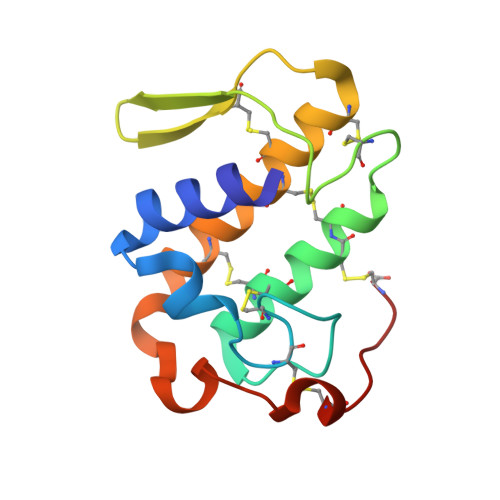Structural and functional evidence for membrane docking and disruption sites on phospholipase A2-like proteins revealed by complexation with the inhibitor suramin.
Salvador, G.H., Dreyer, T.R., Cavalcante, W.L., Matioli, F.F., Dos Santos, J.I., Velazquez-Campoy, A., Gallacci, M., Fontes, M.R.(2015) Acta Crystallogr D Biol Crystallogr 71: 2066-2078
- PubMed: 26457430
- DOI: https://doi.org/10.1107/S1399004715014443
- Primary Citation of Related Structures:
4YV5 - PubMed Abstract:
Local myonecrosis resulting from snakebite envenomation is not efficiently neutralized by regular antivenom administration. This limitation is considered to be a significant health problem by the World Health Organization. Phospholipase A2-like (PLA2-like) proteins are among the most important proteins related to the muscle damage resulting from several snake venoms. However, despite their conserved tertiary structure compared with PLA2s, their biological mechanism remains incompletely understood. Different oligomeric conformations and binding sites have been identified or proposed, leading to contradictory data in the literature. In the last few years, a comprehensive hypothesis has been proposed based on fatty-acid binding, allosteric changes and the presence of two different interaction sites. In the present study, a combination of techniques were used to fully understand the structural-functional characteristics of the interaction between suramin and MjTX-II (a PLA2-like toxin). In vitro neuromuscular studies were performed to characterize the biological effects of the protein-ligand interaction and demonstrated that suramin neutralizes the myotoxic activity of MjTX-II. The high-resolution structure of the complex identified the toxin-ligand interaction sites. Calorimetric assays showed two different binding events between the protein and the inhibitor. It is demonstrated for the first time that the inhibitor binds to the surface of the toxin, obstructing the sites involved in membrane docking and disruption according to the proposed myotoxic mechanism. Furthermore, higher-order oligomeric formation by interaction with interfacial suramins was observed, which may also aid the inhibitory process. These results further substantiate the current myotoxic mechanism and shed light on the search for efficient inhibitors of the local myonecrosis phenomenon.
Organizational Affiliation:
Department of Physics and Biophysics, Institute of Biosciences, UNESP - Universidade Estadual Paulista, Botucatu-SP, Brazil.


















